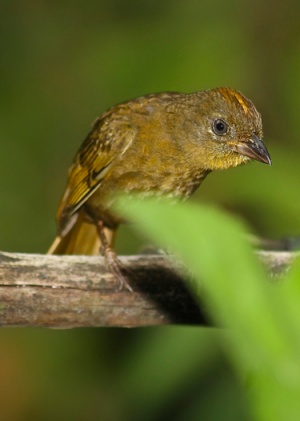- Habia rubica
Identification
17–19 cm (6¾-7½ in)
- Dull reddish brown overall plumage
- Red throat and breast
- Black-bordered scarlet crown stripe
Female: yellowish brown, with a yellow throat and yellow-buff crown stripe
Similar Species
The Red-throated Ant Tanager can be difficult to distinguish. It lacks the black borders on the crown stripe.
Distribution
Central and South America: found in Mexico, Nicaragua, Costa Rica, Panama, Trinidad, Venezuela, Colombia, Peru, Bolivia, Paraguay and Argentina.
Taxonomy
Subspecies
There are 17 subspecies[1]:
- H. r. holobrunnea: Subtropical eastern Mexico (southern Tamaulipas to Veracruz and northern Oaxaca)
- H. r. rosea: Pacific slope of south-western Mexico (Nayarit and Jalisco to Guerrero)
- H. r. affinis: Pacific slope of southern Mexico (Oaxaca)
- H. r. nelsoni: South East Mexico (Yucatán Peninsula north of southern Campeche)
- H. r. rubicoides: South Mexico (Puebla and eastern Veracruz) to northern Nicaragua
- H. r. alfaroana: North West Costa Rica (Guanacaste Peninsula)
- H. r. vinacea: Pacific slope of south-western Costa Rica (Nicoya Peninsula) to eastern Panama
- H. r. rubra: Trinidad
- H. r. crissalis: Coastal mountains of north-eastern Venezuela (Anzoátegui to Sucre)
- H. r. mesopotamia: Venezuela (Río Yuruán region of eastern Bolívar)
- H. r. perijana: Sierra de Perijá (Colombia/Venezuela border)
- H. r. coccinea: East base of East Andes of north-central Colombia and western Venezuela
- H. r. rhodinolaema : South East Colombia east of the Andes to north-eastern Peru and extreme north-western Brazil
- H. r. peruviana: Tropical eastern Peru to central Bolivia and adjacent western Brazil
- H. r. hesterna: Central Brazil south of the Amazon to northern Mato Grosso
- H. r. bahiae: Tropical eastern Brazil (Bahia)
- H. r. rubica: South East Brazil (southern Minas Gerais) to eastern Paraguay and north-eastern Argentina
Habitat
Leafy undergrowth of terra firme forest and tall second growth
Behaviour
Diet
Their diet consists mainly of arthropods with the addition of some fruit.
Breeding
They build a shallow cup nest in a tree. The clutch contains 2 white eggs with brown blotches. They are incubated by the female for 13 days. After a further 10 days, the chicks fledge.
References
- Clements, J. F., T. S. Schulenberg, M. J. Iliff, D. Roberson, T. A. Fredericks, B. L. Sullivan, and C. L. Wood. 2017. The eBird/Clements checklist of birds of the world: v2017, with updates to August 2017. Downloaded from http://www.birds.cornell.edu/clementschecklist/download/
- Avibase
- Handbook of the Birds of the World Alive (retrieved June 2018)
Recommended Citation
- BirdForum Opus contributors. (2025) Red-crowned Ant Tanager. In: BirdForum, the forum for wild birds and birding. Retrieved 26 April 2025 from https://www.birdforum.net/opus/Red-crowned_Ant_Tanager






